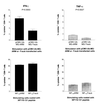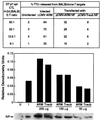Virus-induced diabetes in a transgenic model: role of cross-reacting viruses and quantitation of effector T cells needed to cause disease
- PMID: 10708445
- PMCID: PMC111829
- DOI: 10.1128/jvi.74.7.3284-3292.2000
Virus-induced diabetes in a transgenic model: role of cross-reacting viruses and quantitation of effector T cells needed to cause disease
Abstract
Virus-specific cytotoxic T lymphocytes (CTL) at frequencies of >1/1, 000 are sufficient to cause insulin-dependent diabetes mellitus (IDDM) in transgenic mice whose pancreatic beta cells express as "self" antigen a protein from a virus later used to initiate infection. The inability to generate sufficient effector CTL for other cross-reacting viruses that fail to cause IDDM could be mapped to point mutations in the CTL epitope or its COO(-) flanking region. These data indicate that IDDM and likely other autoimmune diseases are caused by a quantifiable number of T cells, that neither standard epidemiologic markers nor molecular analysis with nucleic acid probes reliably distinguishes between viruses that do or do not cause diabetes, and that a single-amino-acid change flanking a CTL epitope can interfere with antigen presentation and development of autoimmune disease in vivo.
Figures







Similar articles
-
Focal expression of interleukin-2 does not break unresponsiveness to "self" (viral) antigen expressed in beta cells but enhances development of autoimmune disease (diabetes) after initiation of an anti-self immune response.J Clin Invest. 1995 Feb;95(2):477-85. doi: 10.1172/JCI117688. J Clin Invest. 1995. PMID: 7860729 Free PMC article.
-
In vivo treatment with a MHC class I-restricted blocking peptide can prevent virus-induced autoimmune diabetes.J Immunol. 1998 Nov 1;161(9):5087-96. J Immunol. 1998. PMID: 9794447
-
How virus induces a rapid or slow onset insulin-dependent diabetes mellitus in a transgenic model.Immunity. 1994 Jun;1(3):231-42. doi: 10.1016/1074-7613(94)90101-5. Immunity. 1994. PMID: 7889411
-
Molecular and cellular mechanisms, pathogenesis, and treatment of insulin-dependent diabetes obtained through study of a transgenic model of molecular mimicry.Curr Top Microbiol Immunol. 2005;296:65-87. doi: 10.1007/3-540-30791-5_5. Curr Top Microbiol Immunol. 2005. PMID: 16329191 Review.
-
Using transgenic mouse models to dissect the pathogenesis of virus-induced autoimmune disorders of the islets of Langerhans and the central nervous system.Immunol Rev. 1996 Aug;152:111-43. doi: 10.1111/j.1600-065x.1996.tb00913.x. Immunol Rev. 1996. PMID: 8930670 Review.
Cited by
-
T-cell exhaustion: understanding the interface of chronic viral and autoinflammatory diseases.Immunol Cell Biol. 2016 Nov;94(10):935-942. doi: 10.1038/icb.2016.81. Immunol Cell Biol. 2016. PMID: 27577866 Review.
-
Common antiviral cytotoxic t-lymphocyte epitope for diverse arenaviruses.J Virol. 2001 Jul;75(14):6273-8. doi: 10.1128/JVI.75.14.6273-6278.2001. J Virol. 2001. PMID: 11413293 Free PMC article.
-
Altered immune regulation in type 1 diabetes.Clin Dev Immunol. 2013;2013:254874. doi: 10.1155/2013/254874. Epub 2013 Aug 21. Clin Dev Immunol. 2013. PMID: 24285974 Free PMC article. Review.
-
Molecular anatomy and number of antigen specific CD8 T cells required to cause type 1 diabetes.PLoS Pathog. 2012;8(11):e1003044. doi: 10.1371/journal.ppat.1003044. Epub 2012 Nov 29. PLoS Pathog. 2012. PMID: 23209415 Free PMC article.
-
One in Ten CD8+ Cells in the Pancreas of Living Individuals With Recent-Onset Type 1 Diabetes Recognizes the Preproinsulin Epitope PPI15-24.Diabetes. 2021 Mar;70(3):752-758. doi: 10.2337/db20-0908. Epub 2021 Jan 7. Diabetes. 2021. PMID: 33414250 Free PMC article.
References
-
- Baekkeskov S, Hansen B, editors. Human diabetes: Genetic, environmental and autoimmune etiology. Vol. 164. Heidelberg, Germany: Springer-Verlag; 1990.
-
- Buchmeier M J, Lewicki H A, Tomori O, Oldstone M B A. Monoclonal antibodies to lymphocytic choriomeningitis and pichinde viruses: generation, characterization, and cross-reactivity with other arenaviruses. Virology. 1981;113:73–85. - PubMed
Publication types
MeSH terms
Substances
Grants and funding
LinkOut - more resources
Full Text Sources
Medical

